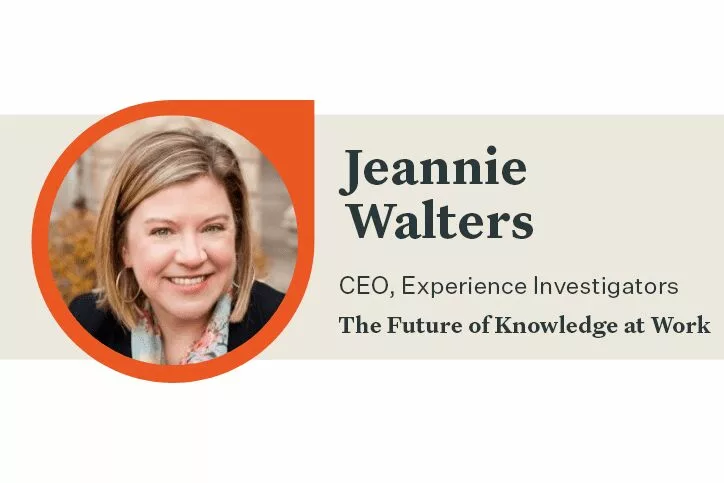Bloomfire Q&A: Jeannie Walters, CEO of Experience Investigators, on the Evolution of CX

At Bloomfire, we’ve seen that company-wide knowledge engagement and customer experience (CX) go hand in hand. By centralizing knowledge, from customer data to best practices, organizations are better equipped to deliver consistent experiences and meet the complex and evolving needs of their customers.
Since CX is a topic that’s near and dear to us, we’re always happy to have the opportunity to speak with leaders in the field. For this entry in our Future of Knowledge at Work series, we’re thrilled to share insights from Jeannie Walters, Founder and CEO of CX consulting firm Experience Investigators.
Jeannie is a Certified Customer Experience Professional (CCXP) who has helped business leaders at a variety of organizations including Verizon, Allstate, and Siemens. She’s also a LinkedIn Learning instructor, a TEDx speaker, and an active writer and blogger. Check out our interview below:
Tell us a little about yourself.
I live right outside Chicago in Oak Park, Illinois with my husband, our two teenage boys, and our dog Harvey (who often makes appearances in the Experience Investigators newsletter). Our family typically has a lot of activities going on: we are very active with sports for my younger son, and my older son is very involved with lots of tech-driven things (he’s become my de facto production assistant as I make videos from home now). We enjoy travel, and we often visit friends in places where we can go hiking and spend time outdoors.
How did you get started in your career in customer experience investigation?
Like many people, I didn’t go to kindergarten and tell my teacher I wanted to be a customer experience professional: it came later in life.
I started focusing on customer experience in the late ‘90s. I had a role in an organization I ran with my brother where we were focused on communications and marketing, and I remember at one point being in a meeting and looking around and thinking, “No one is here for the customer.” That’s really when we put a stake in the ground and said we were going to be a customer experience firm. That started my journey and since then, I’ve been exploring, learning, and trying to grow the actual industry of customer experience.
I’ve been running my business, Experience Investigators, since 2009, and part of what I do is break down the barriers between customer and brand. Customers can reach out to brands in lots of different ways, and we have to figure out what to do and how to respond to all these different points of input.
I really believe it’s about science–gathering the right feedback, measuring it, responding to it–but there’s also this wonderful part of it that’s all nuance and art and humanity, and that’s the part that I get really excited about.
What knowledge do you rely on most in your role as a CX consultant and trainer?
I get excited about the emotional, human side of things because if we get that right, we can create better CX strategies and tactics. When I’m talking to corporate leaders, I always do some research on their vision and value statements, whether they have a CX mission, and what their customers say about them. If you tap into that knowledge, then you can identify the gap between the promise and what’s being delivered.
From there, we can start asking, “How can we get closer to that? How can we put in the right processes, strategies, and employees to deliver on that promise?” Because that’s what this is: it’s about delivering on promises no matter what.
Based on your consulting and training experience, what do you think are the biggest knowledge management challenges facing organizations that want to be more customer-centric?
I think it’s the age-old problem of the employee who does things really well, has it all figured out, and then leaves with all their knowledge. I still don’t think we’re doing a great job in general of identifying the best practices that are happening with the best employees and then turning that into knowledge for everybody else.
That’s something that I think we overlook a lot because it’s easy to stay focused on fixing the negative in customer experience. But if you’re really keeping your radar up for what’s going well, a lot of the time that comes down to specific employees or scenarios, and if you translate that into a better process or best practice and share that knowledge, that’s where you can start delivering consistency. And that’s what makes a great customer experience.
Thoughts on how new technologies will impact the way different teams share and engage with knowledge about the customer, especially when so many teams are decentralized?
We still have places where we just don’t have the right data centralization–we’re getting there, but we still have a ways to go. In order to deliver personalized experiences to a customer, you need to know everything you can about them–their history, where they just came from. If data is housed in all these different places, that’s really hard to deliver on. And customers don’t want to be stuck in a situation where they can’t get the answer they want from a chatbot, so they pick up the phone, but the person who answers has no idea they already had this chatbot experience. That’s a recipe for frustration.
We’re seeing more organizations putting resources towards data centralization, but with some of these legacy systems, it’s heavy lifting. There are still many places we can’t quite create that seamless, effortless experience simply because the data is not centralized. I think that’s a big challenge that enterprise-level organizations are grappling with right now because they’re realizing just how important it is to customer experience.
What best practices would you recommend to break down silos and make CX central to an organization?
Start with a CX success statement. If you haven’t defined that, it’s really easy to just say, “Okay, everyone. Do great customer experience.” That can mean totally different things to different leaders. Without a success statement, you could say something like, “Hey, we got our NPS score up,” and other leaders have no idea what that means. It’s not tied to the business goals or outcomes that everyone else is looking at, and it’s easy to dismiss. And I think that’s been happening to CX leaders for the last 5-10 years.
This is so important that we created a CX Success Statement Workbook with a series of fill-in-the-blank exercises to help leaders create their own statement.
Once you have that definition, you can tie it to the other leaders and say, “If we do this well, we can reduce the cost of service, have higher profitability, higher retention, etc.” The key is helping other leaders understand what CX success means for them. And having a CX mission statement that explains who you are and the experience you deliver is also important because that’s how you can identify your best practices and articulate them throughout the organization.
A lot of the time, it takes a lot of storytelling, hand-holding, and relationship building to get to a place where everyone understands the CX mission.
What’s one piece of advice you’d like to offer to anyone who wants to continue growing in their career as a CX professional?
Learn as much as you can. There are tons of resources now. I like the Customer Experience Professionals Association (CXPA): they have educational resources, you can reach out to peers, and you can study and take the exam to get your CCXP certification.
My other piece of advice is to figure out what part of CX you love the best. It’s really easy to think you know customer experience, but when you start scratching the surface, you see this is a broad and deep topic. There’s room for a wide range of interests, from design thinking to examining data to improving the experience.
I have found that people are really willing to help each other in this field. We know that none of us went to school for this or got a playbook that told us exactly what to do. As expectations and tools change, we’re all figuring it out together. I’ve been really pleased and proud of the industry because of the ways people help one another.
Editor’s Note: Readers who are interested in learning more about CX from Jeannie can check out her LinkedIn Learning courses for free for 30 days.
Thank you for sharing your expertise, Jeannie!

How to Build an Insights Engine: The People, Technology, and Culture You Need

How to Measure the ROI of Knowledge Management

How to Navigate the Chain of Command in Business to Get Executive Buy-in

Start working smarter with Bloomfire
See how Bloomfire helps companies find information, create insights, and maximize value of their most important knowledge.

Take a self guided Tour
See Bloomfire in action across several potential configurations. Imagine the potential of your team when they stop searching and start finding critical knowledge.